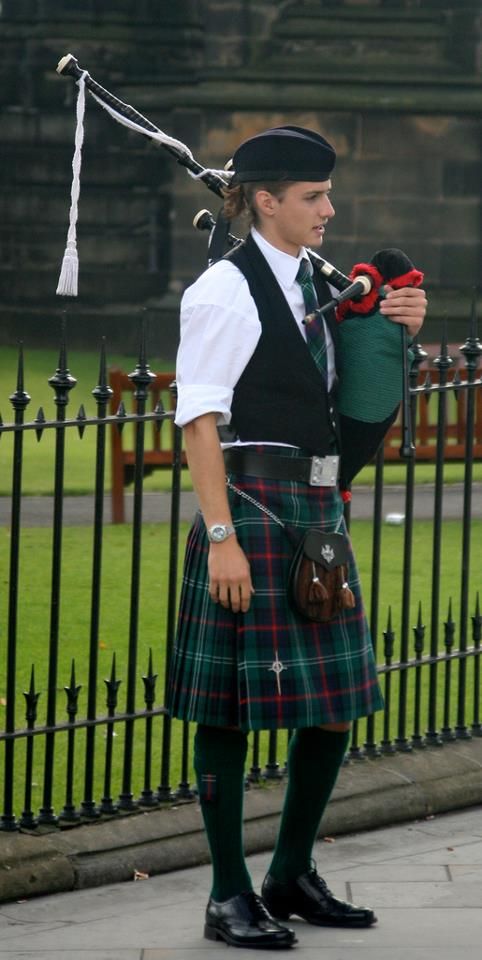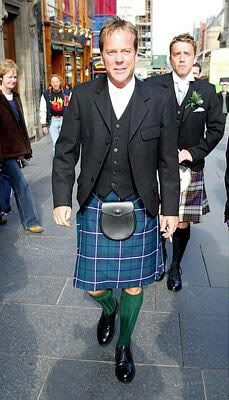Posted by Anna on 19th Oct 2022
Historical Story Of Sutherland Clan And Tartan
Sutherland Tartan definitely comes from the Sutherland clan, but do you know about this Scottish clan? Let's find out all about the Sutherland clan and tartan through this article.
Sutherland Clan
The Clan's lands are, unsurprisingly, in Sutherland in the Highlands. Alistair Sutherland, Earl of Sutherland, is the current Chief. He took over from Elizabeth Millicent Sutherland, the 24th Countess of Sutherland. Elizabeth was a Scottish noblewoman who inherited the Chiefship from her uncle, who was appointed as her legal guardian when her parents died when she was a child. To succeed her uncle as Chief, she had to drop the double barrels from her surname.
Where Does The Name Sutherland Come From?
Clan Sutherland is named after the county of Sutherland in northern Scotland. The name derives from "Sudrland," which translates loosely as "southern land," and refers to land south of the Norse earldoms of Orkney and Caithness. Sutherlands are thought to be of Flemish origin because they are descended from Freskin, who is an ancestor of the clan Murray.
Despite their apparent closeness to another clan, the Sutherlands had several longstanding feuds with other families, including the Sinclairs of Caithness, the MacKays, and the MacLeods, to name a few. The 11th Earl of Sutherland and his wife were poisoned by the Earl of Caithness in one of these feuds. "Sans Peur" (Without Fear) is the Sutherland clan motto, and their clan crest depicts a Scottish wild cat.
History Of Sutherland Clan
The history of the Sutherlands is overshadowed by the Clearances of 1814 to 1820 and the bitter controversy that followed. They were, until that point, one of the best examples of collaboration between Gaelic clansmen and a non-Gaelic chieftain line.
However, in just a decade, the Clearances caused the most spectacular collapse of clan loyalty in Highland history. The Lairdship of Sutherland presents an instructive paradox: how did the most northern part of mainland Scotland come to be known as the southland? Because it was to the south, not only of their Norwegian homeland, but also of their great Scottish provinces, which in the 10th and 11th centuries included the entire modern counties of Caithness and Sutherland (which they called 'Sudderland').
The Sutherland family established itself by assisting in their expulsion. Their first known ancestor was Freskin, a Flemish mercenary who was given a commission by King David the First to gather all the Sutherland Gaels together to clear the Norsemen from the north. Freskin was thus most likely the hero of the first great clan legend, the story of the Killing of the Last Norsemen, a pivotal battle that is said to have taken place at Embol near Dornoch, where the Norse chief had gathered all his men in a desperate attempt to halt the Scottish advance. Indeed, the fight began in favor of the Norsemen when they broke through the Scots' formation and cut the Sutherland chief to the ground. As the chief lay wounded, he noticed the Norse General approaching to support the attack and, finding a horseshoe nearby, threw it with all his might, striking the Norseman square on the forehead and turning the battle around.
Hugo received the title Lordship of Sutherland for the first time after he helped the family gain royal favor by defeating a ferocious robber band led by Chisholm. Among other things, Chisholm tortured a number of Sutherland churchmen by nailing horseshoes to their feet and forcing them to dance to entertain his followers before brutally killing them. When King William the Lion learned of the outrage, he directed Hugo of Sutherland to pursue Chisholm to his death, and a great battle ensued near John O'Groats, in which all of the robbers were either killed or captured. Chisholm and the other leaders were sentenced to horseshoeing and hanging, while the rest were castrated "less any succession should spring from such a detestable breed."
Trouble began in 1222 with a dispute over rights imposed by the Bishop of Caithness. His seat was in Dornoch, and the Sinclair Earls of Caithness, based in Wick and Thurso, had long resented the bishopric being controlled by Dornoch Sutherland. Caithness decided to use the discontent to get rid of the bishop and have the seat moved. Soon after, the Caithness supporters incited a riot, and the unfortunate Bishop was roasted alive on his own cow spit, and the rioters fled north. The Lord of Sutherland was once again tasked by the Crown with restoring law and order and punishing Caithness for his role in the incident. A ferocious campaign of vengeance and repression ravaged the far north east. Wick and Thurso were set on fire, the Caithness stronghold was leveled, and 80 men were beheaded or hanged in a summary court session at Golspie. Rioters were eventually subjected to harsh punishment. Four of the ringleaders were roasted on their cow spit and then fed to the Crown dogs as a final punishment. This campaign established the pattern for centuries to come.
Disputed Clan
The Earl of Sutherland was the chief of Clan Sutherland. William Sutherland, the 18th Earl of Sutherland, died in 1766, leaving only one daughter, Elizabeth. This sparked a legal battle over the title's succession. The right of Elizabeth to succeed as a woman was challenged first by George Sutherland of Forse, a direct male descendant of the original de Moravia/Sutherland Earls of Sutherland, and then by Sir Robert Gordon of Gordonstoun, a direct male descendant of the later Gordon Earls of Sutherland. On March 21, 1771, the House of Lords heard the case and ruled in Elizabeth's favor.
In 1833, she married George Leveson-Gower, Marquess of Stafford, who went on to become the first Duke of Sutherland. The Duke established businesses on the coast and ruthlessly evicted his tenants, breaking with the customary obligations of a Scottish clan chief. The clearance of tenants in Sutherland, however, was opposed by two tacksmen of the clan, the brothers Alexander and John Sutherland of Sciberscross. Alexander Sutherland of Sciberscross, an army officer, was a staunch opponent of the clearances and provided much of the London press's critical coverage of the events in Sutherland. In 1813, his brother, John Sutherland of Sciberscross, provided "covert aid" to Kildonan rebels opposing clearances in Sutherland.
Following the death of the fifth Duke of Sutherland, his niece, Elizabeth Sutherland, the 24th Countess of Sutherland, inherited the chiefship of the clan and the earldom of Sutherland.
Dunrobin Castle

Dunrobin Castle
Dunrobin Castle, located in Sutherland in the Scottish Highlands, is the historic seat of Clan Sutherland. The exact date of construction is unknown, but it was before the 16th century, as the castle was captured by Alexander Sutherland in 1518. Since 1973, the Castle has been open to the public.
Sutherland Tartan
Sutherland tartan comes from the Sutherland clan. Some of images of Sutherland tartan:
 \
\
Sutherland tartan

Sutherland tartan

Sutherland tartan

A handsome guy wears Sutherland tartan

Sutherland tartan luggage

A man wears Sutherland tartan
Sutherland tartan is so elegant and never seems to go out of style. Own some Sutherland tartan items here.

